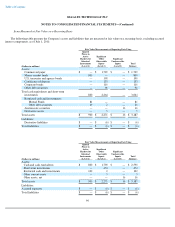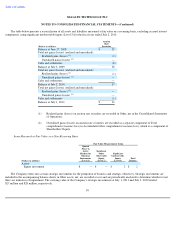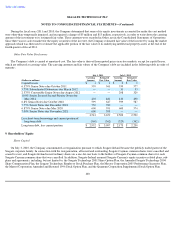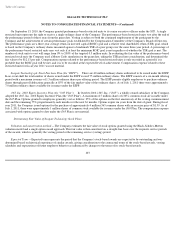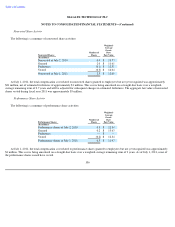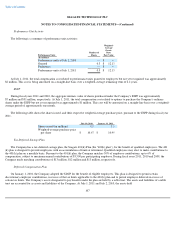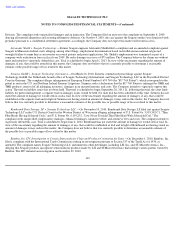Seagate 2010 Annual Report Download - page 110
Download and view the complete annual report
Please find page 110 of the 2010 Seagate annual report below. You can navigate through the pages in the report by either clicking on the pages listed below, or by using the keyword search tool below to find specific information within the annual report.
Table of Contents
SEAGATE TECHNOLOGY PLC
NOTES TO CONSOLIDATED FINANCIAL STATEMENTS—(Continued)
On September 13, 2010, the Company granted performance-based restricted units to its senior executive officers under the SCP. A single
restricted unit represents the right to receive a single ordinary share of the Company. The performance-based restricted units vest after the end of
the performance period of three years from the grant date. Vesting is subject to both the continued employment of the participant by the
Company and the achievement of certain performance goals established by the Compensation Committee of the Company's Board of Directors.
The performance goals are a three-year average return on invested capital (ROIC) goal and a relative total shareholder return (TSR) goal, which
is based on the Company's ordinary shares measured against a benchmark TSR of a peer group over the same three-year period. A percentage of
the performance-based restricted units may vest only if at least the minimum ROIC goal is met regardless of whether the TSR goal is met. The
number of stock units to vest will range from 0% to 200% of the targeted 0.3 million units. In evaluating the fair value of the performance-based
restricted stock unit, the Company used a Monte Carlo simulation on the grant date, taking the TSR goal into consideration, and determined the
fair value to be $12.13 per unit. Compensation expense related to the performance-based restricted units is only recorded in a period if it is
probable that the ROIC goal will be met, and it is to be recorded at the expected level of achievement. Compensation expense related to these
restricted units for fiscal year 2011 was not material.
Seagate Technology plc Stock Purchase Plan (the "ESPP").
There are 40 million ordinary shares authorized to be issued under the ESPP.
In no event shall the total number of shares issued under the ESPP exceed 75 million ordinary shares. The ESPP consists of a six-month offering
period with a maximum issuance of 1.5 million ordinary shares per offering period. The ESPP permits eligible employees to purchase ordinary
shares through payroll deductions generally at 85% of the fair market value of the ordinary shares. As of July 1, 2011 there were approximately
7.0 million ordinary shares available for issuance under the ESPP.
i365, Inc. 2010 Equity Incentive Plan (the "i365 Plan").
In October 2010, i365, Inc. ("i365"), a wholly owned subsidiary of the Company,
adopted the i365, Inc. 2010 Equity Incentive Plan (the "i365 Plan"). A maximum of 5 million shares of i365's common stock are issuable under
the i365 Plan. Options granted to employees generally vest as follows: 25% of the options on the first anniversary of the vesting commencement
date and the remaining 75% proportionately each month over the next 36 months. Options expire ten years from the date of grant. During fiscal
year 2011, the Company issued options for the purchase of approximately 4 million i365 common shares with an exercise price of $1.59. As of
July 1, 2011, there were approximately 1 million shares of common stock available for issuance under the i365 Plan. The compensation expense
associated with options granted to date under the i365 Plan is not material.
Determining Fair Value of Seagate Technology Stock Plans
Valuation and amortization method —The Company estimates the fair value of stock options granted using the Black-Scholes-Merton
valuation model and a single option award approach. This fair value is then amortized on a straight-line basis over the requisite service periods
of the awards, which is generally the vesting period or the remaining service (vesting) period.
Expected Term —Expected term represents the period that the Company's stock-based awards are expected to be outstanding and was
determined based on historical experience of similar awards, giving consideration to the contractual terms of the stock-based awards, vesting
schedules and expectations of future employee behavior as influenced by changes to the terms of its stock-based awards.
103





